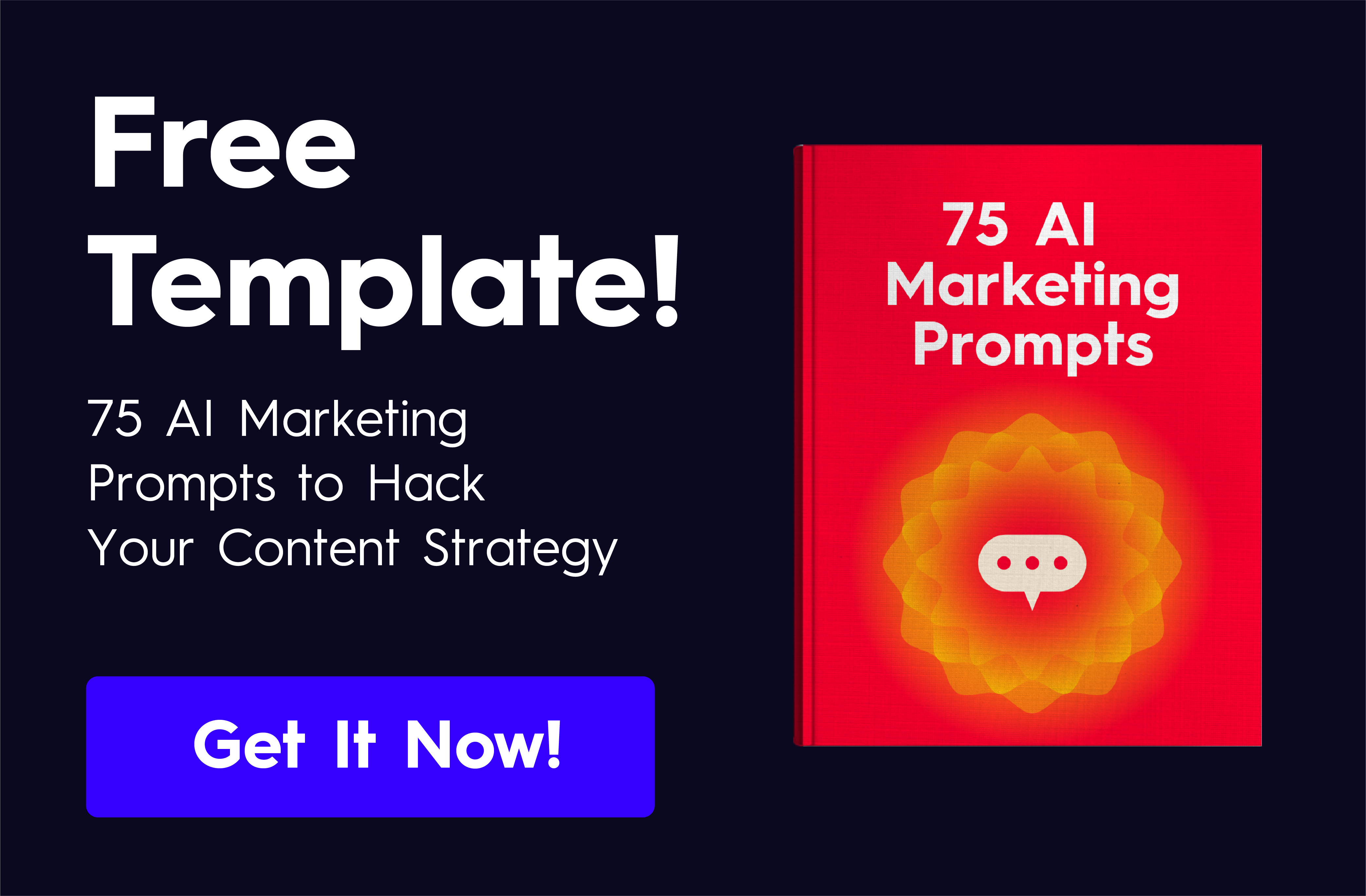There are all sorts of ways AI can improve your marketing, both internally and externally. Whether it’s synthesizing articles for your team to read or segmenting your email list, it can free up your time and brain space to focus on more strategic endeavors. This is especially true when it comes to using AI for social media. Not only can AI help you generate great content but it can help you improve just about every aspect of your social strategy—with less effort.
So, if you’re being asked to do more with less (or struggling to make your social presence pop off), it’s time to try our helpful hacks to use AI for social media.

25 Tips to Use AI for Social Media
Whether you’re looking to increase awareness or establish your brand as a go-to thought leader, here are 25 ways you can use AI to save time, improve efficiency, and boost your social presence.
1) Brainstorm good content ideas.
Tools like ChatGPT or Jasper can be especially helpful for brainstorming unique social ideas, whether you’re looking to create a funny holiday post, a helpful tip series, or an interesting Instagram story. Simply prompt your AI tool with your personas, platform, and preferred medium (e.g., text, photo, or video) to get tailored content ideas that will resonate.
2) Create content quickly.
Whether you need to rewrite a post in your brand voice or turn an article into a quick thread, AI is a great tool to create a higher volume of content with less investment.
3) Design great visuals.
Use AI-powered design tools like Canva’s Magic Switch or DALL-E to create custom images, graphics, or videos that are platform-specific and visually engaging.
Tip: If you’re using these tools to design content, make sure you’re following your brand style guide to ensure content is consistent.
4) Create eye-catching videos.
Social platforms are increasingly prioritizing video, so now is the time to convert your content to video. AI tools like Lumen5 can help you transform blog posts or articles into dynamic videos optimized for social sharing.
5) Repurpose content across platforms.
Automate content adaptation for different platforms using tools like Jasper. This is a great way to expand your reach while maintaining consistent brand messaging.
Tip: It’s easier to repurpose content if you use a divisible content strategy, wherein you break larger pieces of content up into multiple posts (and formats) across channels.
6) Analyze audience sentiment.
Use AI-powered insights from tools like Brandwatch or Talkwalker to find out what people are saying about your brand and industry—and gauge audience sentiment in real time. These insights can help you inform your social strategy, as well as your larger content strategy.
7) Optimize posting times.
Use AI-driven scheduling tools like Buffer to determine the best times to post based on your audience’s historical engagement data. This helps ensure you hit their feeds at the best time.
8) Automate audience segmentation.
Use AI platforms like HubSpot to segment your audience by behavior, demographics, or past interactions to deliver personalized content.
Tip: The more personalized your content is, the more likely people are to engage with it. Follow our tips to use AI to infuse more personalization throughout the buyer journey.
9) Deploy chatbots to engage people in your DMs.
If you want to immediately engage and educate your audience about your brand, implement AI chatbots like ManyChat or Customers.ai that provide instant customer support, answer FAQs, and guide users through the sales funnel—straight from your social channels.
10) Monitor social trends.
Keeping up on the latest trends is pretty exhausting, especially when they are short-lived on social media (thanks, TikTok). But you can easily track these conversation topics and cultural moments through AI tools like Sprinklr. This can help you easily create timely, relevant content that pops off.
Tip: Not all trends or trending topics are appropriate for your brand to comment on or participate in. To avoid getting attention for the wrong reason, see our guide to newsjack the right way.
11) Conduct a competitor analysis.
If you want to outshine your competition on social, you need to know what they’re doing to connect with followers. Use AI-powered tools to analyze competitors’ social strategies, content performance, and audience engagement to find ways to make your strategy more successful.
Tip: No matter what tweaks you make to your social strategy, you need to measure your efforts to gauge success. See our guide to choose the right metrics for your social media.
12) Perform sentiment analysis.
If you want to make more meaningful connections with your audience via social, you need to understand how they feel about your brand. Use AI tools to analyze the sentiment of comments, reviews, and mentions. This can give you inspiration for topics to address on social media (e.g., product education, behind-the-scenes, customer spotlights, etc.).
Tip: No matter your brand’s product/service, people want to know who is behind the brand. Adding brand culture content your social mix can help you put a human face to your brand and entice the right audience, as well as potential employees.
13) Optimize ad targeting and bidding.
Paid media is a huge part of any brand’s social strategy. You need to invest wisely and efficiently. AI tools like Facebook Ads Manager help automatically adjust targeting, bidding, and placements to maximize ad performance.
14) A/B test your social ads.
Use tools like AdCreative.ai to create and test multiple types of copy, headlines, visuals, and CTAs to find the most effective combinations. This will help you optimize your spend and increase your success.
Tip: We are big fans of taking a test-and-learn approach to social media, as well as other aspects of your marketing strategy. Find out how to use an agile marketing strategy to run efficient campaigns (like the time we outperformed our industry CTR 155%).
15) Curate content.
Even if you don’t post original content every day, staying active on your social media platforms via commenting, engaging, or sharing content can help improve your presence. Leverage tools to curate high-quality content from across the web, such as articles, videos, or infographics, that your audience will find valuable. This keeps your feed fresh and engaging without having to create content from scratch.
Tip: New industry research, trends, and data are particularly popular with B2B audiences. If you share regular roundups of the latest insights, you can become a go-to source for the latest industry info.
16) Predict content performance.
Use predictive analytics tools like Emplifi to forecast how well different content types will perform. As you gather more data, you can make better decisions about your social strategy, allocate resources more effectively, and improve your social ROI all around.
17) Find relevant holidays and events.
Social media is all about trends and seasonal content. But tracking down each holiday, cultural event, or “awareness” month takes time. Ask AI to source important dates throughout the year that may be relevant to your audience or industry.
18) Automate your content calendar.
Planning your editorial calendar can be a tedious task. What holidays do you need to be aware of? What type of content should be published when? Use AI tools to easily plan, schedule, and manage your content calendar to ensure you have a steady cadence of quality content.
Tip: Although AI is a science, there is an art to creating a strong editorial calendar for your audience. Find out more about how to craft the right content mix to generate value and brand awareness, and use our editorial calendar template to document your AI-generated calendar.
19) Find trending hashtags.
Use hashtag tools to find trending and relevant hashtags based on your content type, audience, and current trends. This is an easy way to increase the reach and visibility of your posts.
20) Find the perfect influencer partners.
We are entering the age of the microinfluencer—people whose audiences are more niche and more valuable to brands. Use AI tools like AspireIQ to identify influencers that align with your goals and brand heart.
21) Measure influencer ROI.
Use AI analytics tools to track influencer performance, engagement rates, and conversions, ensuring your influencer marketing efforts deliver value.
22) Write better captions.
We often find that the little things (like social captions) can be the hardest to write—especially if you have a limited character count. AI tools can help you generate on-brand captions that will engage your audience and better reflect your brand.
24) Automate follow-ups.
Again, personalization always creates a better brand experience, so look for more opportunities to infuse it throughout your social media interactions. Things like personalized follow-up messages, email sign-ups, or retargeting can all boost conversion rates.
25) Improve accessibility for videos.
There are great AI tools like Otter.ai that auto-generate captions and transcripts for video content, which helps improve accessibility (and even SEO for voice search). Note: video captions are helpful for any audience—whether they’re hearing impaired or not.
How to Make AI Work for You
Social media is just one portion of your larger marketing infrastructure, and each piece can benefit from AI in a specific way. If you don’t have much practice implementing or experimenting with these tools, we have a few suggestions to make it easier.
- Do a deeper AI dive. See our guide to AI marketing to find out everything you need to know about how AI can transform your results and ROI.
- Use the right tools. If you want to create winning marketing, you need powerful and effective AI tools. See our roundup of 50+ tools to get started.
- Find out how other brands are winning with AI. From increased traffic to better email open rates, see our roundup of AI-driven case studies to see what smart AI marketing looks like in real life.
That said, if you just don’t have the bandwidth or brain space to master a whole new suite of tools and tech, you might want to use an agency’s expertise to improve your infrastructure with AI. If so, find out how to find the best AI marketing agency for your goals, or talk to us about how we can help your brand work more efficiently.
Either way, we highly encourage you to start experimenting with AI tools—even on a small scale. If you can increase your efficiency just 10%, you can improve your productivity, energy, and results, making you a more effective marketer every day.





